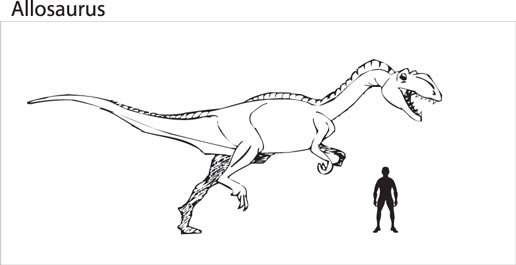Allosaurs on the Hunt in Spain
A partial theropod tooth measuring nearly 10 cm in length has been discovered in Spain.
Scientists from the Teruel-Dinopolis Joint Palaeontology Foundation in Spain have been busy examining a single broken tooth from a large meat-eating dinosaur found in the Riodeva area, approximately 100 miles west of Madrid. The shape and size of this tooth (9.83 cm long), have left the researchers in no doubt that this is evidence of a large allosaur roaming around this part of Spain approximately 155 million years ago. The tooth is the largest yet found in the country and indicates that whatever type of animal lost this tooth, it probably was the apex predator in the region.
Commenting on the classification, Luis Alcalá, one of the researchers involved with the study stated:
“Given the great variations between the teeth of different kinds of allosauroids, it would be prudent for us to assign this fossil to an indeterminate Allosauroidea”.
Theropod Tooth
Allosaurs are classified as part of the theropod tetanuran group (stiff tails). They were large, bipedal predatory dinosaurs with deep skulls and were notable for having prominent brow bumps or ridges along the tops of their skulls. Known from the Jurassic of Northern Hemisphere, this group became rare into the Cretaceous but survived in the south and became some of the largest meat-eating dinosaurs known to science with animals such as the Carcharodontosaurids dominating the food chains of Africa and South America.
The paper on this single tooth is due to be published in the upcoming issue of Estudios Geológicos.
The single, curved and sharply pointed tooth was found by locals in Riodeva, Teruel and is from the Villar del Arzobispo Formation. Comparisons with other Allosauroidea fossils from the Iberian Peninsula have shown that this is the largest tooth of a meat-eating dinosaur found in the country to date. A tooth measuring 12.7cm was discovered in Portugal a few years ago, this too is believed to represent a member of the Allosauroidea.
A Jurassic Ecosystem
The scientists hope to be able to build up an accurate picture of the ecosystem in this part of Jurassic Europe, one of the few parts of what we now know as continental Europe that was not covered with warm, shallow, tropical sea. To date, fossils of stegosaurids, ornithopods and sauropods have been found in the region, now they have evidence of a top predator, although the remains of smaller theropods had been discovered previously.
Meat-eating dinosaurs shed teeth throughout their lives, hence one of the reasons for their nickname “land sharks”. This particular tooth and the condition of its crown (without any re-absorption surfaces), may indicate that this tooth was shed from the jaws of a decaying corpse. If this is the case then further remains of the dinosaur may be uncovered and the palaeontologists may be able to get a lot closer to this giant carnivore than previously thought.
An Illustration of a Typical Allosaurus Dinosaur

Picture credit: Everything Dinosaur
Over the years, Allosaurus has proved to be one of the most popular of all the meat-eating dinosaurs to make models of. The best specimens are known from the Late Jurassic strata of the USA, for example the Morrison Formation.
To view a model of a typical Allosaurus and other meat-eating dinosaurs take a look at the Wild Safari Prehistoric World model range: Safari Ltd. Wild Safari Prehistoric World Models.






Leave A Comment